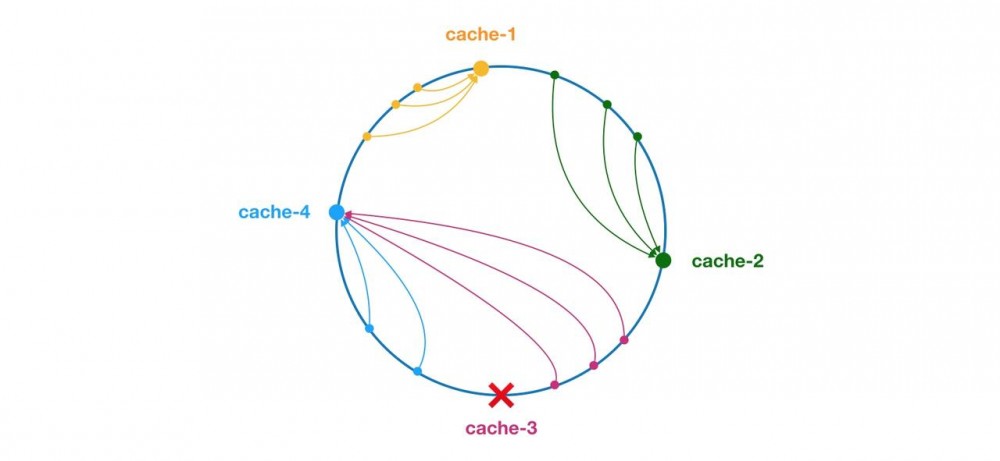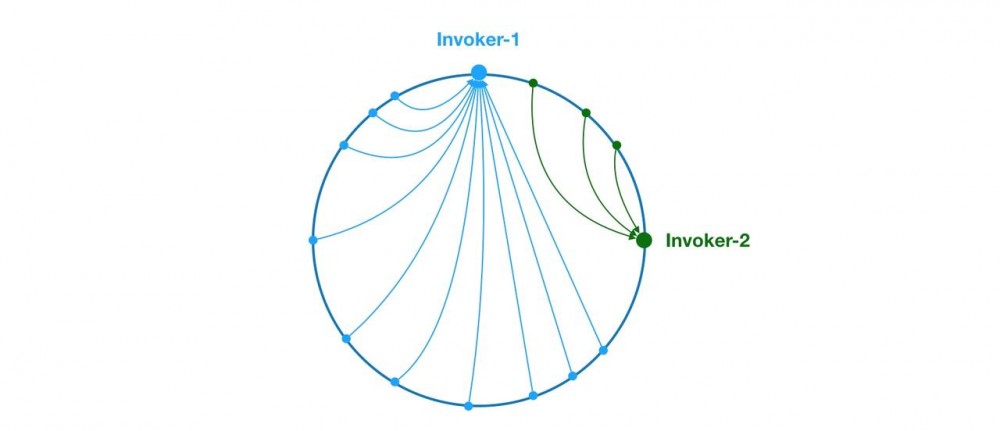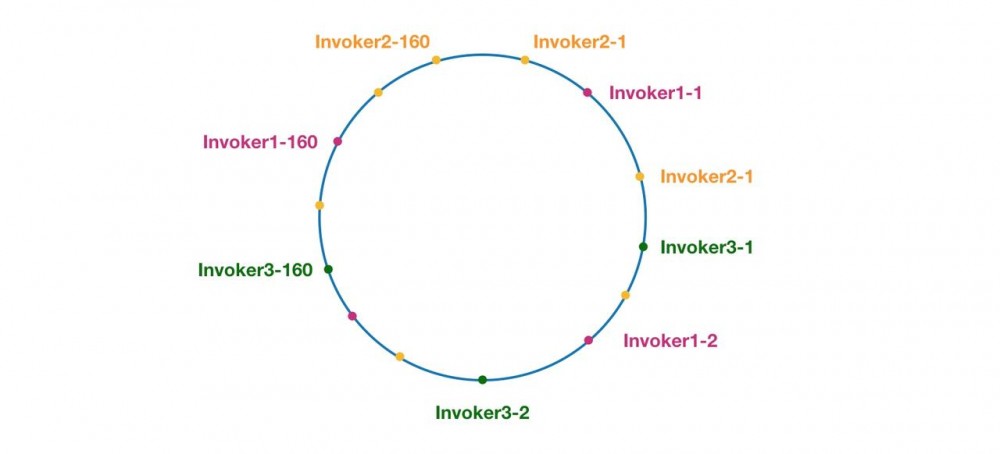Dubbo源码解析(三十八)集群——LoadBalance
目标:介绍dubbo中集群的负载均衡,介绍dubbo-cluster下loadBalance包的源码。
前言
负载均衡,说的通俗点就是要一碗水端平。在这个时代,公平是很重要的,在网络请求的时候同样是这个道理,我们有很多机器,但是请求老是到某个服务器上,而某些服务器又常年空闲,导致了资源的浪费,也增加了服务器因为压力过载而宕机的风险。这个时候就需要负载均衡的出现。它就相当于是一个天秤,通过各种策略,可以让每台服务器获取到适合自己处理能力的负载,这样既能够为高负载的服务器分流,还能避免资源浪费。负载均衡分为软件的负载均衡和硬件负载均衡,我们这里讲到的是软件负载均衡,在dubbo中,需要对消费者的调用请求进行分配,避免少数服务提供者负载过大,其他服务空闲的情况,因为负载过大会导致服务请求超时。这个时候就需要负载均衡起作用了。Dubbo 提供了4种负载均衡实现:
- RandomLoadBalance:基于权重随机算法
- LeastActiveLoadBalance:基于最少活跃调用数算法
- ConsistentHashLoadBalance:基于 hash 一致性
- RoundRobinLoadBalance:基于加权轮询算法
具体的实现看下面解析。
源码分析
(一)AbstractLoadBalance
该类实现了LoadBalance接口,是负载均衡的抽象类,提供了权重计算的功能。
1.select
@Override
public <T> Invoker<T> select(List<Invoker<T>> invokers, URL url, Invocation invocation) {
// 如果invokers为空则返回空
if (invokers == null || invokers.isEmpty())
return null;
// 如果invokers只有一个服务提供者,则返回一个
if (invokers.size() == 1)
return invokers.get(0);
// 调用doSelect进行选择
return doSelect(invokers, url, invocation);
}
复制代码
该方法是选择一个invoker,关键的选择还是调用了doSelect方法,不过doSelect是一个抽象方法,由上述四种负载均衡策略来各自实现。
2.getWeight
protected int getWeight(Invoker<?> invoker, Invocation invocation) {
// 获得 weight 配置,即服务权重。默认为 100
int weight = invoker.getUrl().getMethodParameter(invocation.getMethodName(), Constants.WEIGHT_KEY, Constants.DEFAULT_WEIGHT);
if (weight > 0) {
// 获得启动时间戳
long timestamp = invoker.getUrl().getParameter(Constants.REMOTE_TIMESTAMP_KEY, 0L);
if (timestamp > 0L) {
// 获得启动总时长
int uptime = (int) (System.currentTimeMillis() - timestamp);
// 获得预热需要总时长。默认为10分钟
int warmup = invoker.getUrl().getParameter(Constants.WARMUP_KEY, Constants.DEFAULT_WARMUP);
// 如果服务运行时间小于预热时间,则重新计算服务权重,即降权
if (uptime > 0 && uptime < warmup) {
weight = calculateWarmupWeight(uptime, warmup, weight);
}
}
}
return weight;
}
复制代码
该方法是获得权重的方法,计算权重在calculateWarmupWeight方法中实现,该方法考虑到了jvm预热的过程。
3.calculateWarmupWeight
static int calculateWarmupWeight(int uptime, int warmup, int weight) {
// 计算权重 (uptime / warmup) * weight,进度百分比 * 权重
int ww = (int) ((float) uptime / ((float) warmup / (float) weight));
// 权重范围为 [0, weight] 之间
return ww < 1 ? 1 : (ww > weight ? weight : ww);
}
复制代码
该方法是计算权重的方法,其中计算公式是(uptime / warmup) * weight,含义就是进度百分比 * 权重值。
(二)RandomLoadBalance
该类是基于权重随机算法的负载均衡实现类,我们先来讲讲原理,比如我有有一组服务器 servers = [A, B, C],他们他们对应的权重为 weights = [6, 3, 1],权重总和为10,现在把这些权重值平铺在一维坐标值上,分别出现三个区域,A区域为[0,6),B区域为[6,9),C区域为[9,10),然后产生一个[0, 10)的随机数,看该数字落在哪个区间内,就用哪台服务器,这样权重越大的,被击中的概率就越大。
public class RandomLoadBalance extends AbstractLoadBalance {
public static final String NAME = "random";
/**
* 随机数产生器
*/
private final Random random = new Random();
@Override
protected <T> Invoker<T> doSelect(List<Invoker<T>> invokers, URL url, Invocation invocation) {
// 获得服务长度
int length = invokers.size(); // Number of invokers
// 总的权重
int totalWeight = 0; // The sum of weights
// 是否有相同的权重
boolean sameWeight = true; // Every invoker has the same weight?
// 遍历每个服务,计算相应权重
for (int i = 0; i < length; i++) {
int weight = getWeight(invokers.get(i), invocation);
// 计算总的权重值
totalWeight += weight; // Sum
// 如果前一个服务的权重值不等于后一个则sameWeight为false
if (sameWeight && i > 0
&& weight != getWeight(invokers.get(i - 1), invocation)) {
sameWeight = false;
}
}
// 如果每个服务权重都不同,并且总的权重值不为0
if (totalWeight > 0 && !sameWeight) {
// If (not every invoker has the same weight & at least one invoker's weight>0), select randomly based on totalWeight.
int offset = random.nextInt(totalWeight);
// Return a invoker based on the random value.
// 循环让 offset 数减去服务提供者权重值,当 offset 小于0时,返回相应的 Invoker。
// 举例说明一下,我们有 servers = [A, B, C],weights = [6, 3, 1],offset = 7。
// 第一次循环,offset - 6 = 1 > 0,即 offset > 6,
// 表明其不会落在服务器 A 对应的区间上。
// 第二次循环,offset - 3 = -2 < 0,即 6 < offset < 9,
// 表明其会落在服务器 B 对应的区间上
for (int i = 0; i < length; i++) {
offset -= getWeight(invokers.get(i), invocation);
if (offset < 0) {
return invokers.get(i);
}
}
}
// If all invokers have the same weight value or totalWeight=0, return evenly.
// 如果所有服务提供者权重值相同,此时直接随机返回一个即可
return invokers.get(random.nextInt(length));
}
}
复制代码
该算法比较好理解,当然 RandomLoadBalance 也存在一定的缺点,当调用次数比较少时,Random 产生的随机数可能会比较集中,此时多数请求会落到同一台服务器上,不过影响不大。
(三)LeastActiveLoadBalance
该负载均衡策略基于最少活跃调用数算法,某个服务活跃调用数越小,表明该服务提供者效率越高,也就表明单位时间内能够处理的请求更多。此时应该选择该类服务器。实现很简单,就是每一个服务都有一个活跃数active来记录该服务的活跃值,每收到一个请求,该active就会加1,,没完成一个请求,active就会减1。在服务运行一段时间后,性能好的服务提供者处理请求的速度更快,因此活跃数下降的也越快,此时这样的服务提供者能够优先获取到新的服务请求。除了最小活跃数,还引入了权重值,也就是当活跃数一样的时候,选择利用权重法来进行选择,如果权重也一样,那么随机选择一个。
public class LeastActiveLoadBalance extends AbstractLoadBalance {
public static final String NAME = "leastactive";
/**
* 随机器
*/
private final Random random = new Random();
@Override
protected <T> Invoker<T> doSelect(List<Invoker<T>> invokers, URL url, Invocation invocation) {
// 获得服务长度
int length = invokers.size(); // Number of invokers
// 最小的活跃数
int leastActive = -1; // The least active value of all invokers
// 具有相同“最小活跃数”的服务者提供者(以下用 Invoker 代称)数量
int leastCount = 0; // The number of invokers having the same least active value (leastActive)
// leastIndexs 用于记录具有相同“最小活跃数”的 Invoker 在 invokers 列表中的下标信息
int[] leastIndexs = new int[length]; // The index of invokers having the same least active value (leastActive)
// 总的权重
int totalWeight = 0; // The sum of with warmup weights
// 第一个最小活跃数的 Invoker 权重值,用于与其他具有相同最小活跃数的 Invoker 的权重进行对比,
// 以检测是否“所有具有相同最小活跃数的 Invoker 的权重”均相等
int firstWeight = 0; // Initial value, used for comparision
// 是否权重相同
boolean sameWeight = true; // Every invoker has the same weight value?
for (int i = 0; i < length; i++) {
Invoker<T> invoker = invokers.get(i);
// 获取 Invoker 对应的活跃数
int active = RpcStatus.getStatus(invoker.getUrl(), invocation.getMethodName()).getActive(); // Active number
// 获得该服务的权重
int afterWarmup = getWeight(invoker, invocation); // Weight
// 发现更小的活跃数,重新开始
if (leastActive == -1 || active < leastActive) { // Restart, when find a invoker having smaller least active value.
// 记录当前最小的活跃数
leastActive = active; // Record the current least active value
// 更新 leastCount 为 1
leastCount = 1; // Reset leastCount, count again based on current leastCount
// 记录当前下标值到 leastIndexs 中
leastIndexs[0] = i; // Reset
totalWeight = afterWarmup; // Reset
firstWeight = afterWarmup; // Record the weight the first invoker
sameWeight = true; // Reset, every invoker has the same weight value?
// 如果当前 Invoker 的活跃数 active 与最小活跃数 leastActive 相同
} else if (active == leastActive) { // If current invoker's active value equals with leaseActive, then accumulating.
// 在 leastIndexs 中记录下当前 Invoker 在 invokers 集合中的下标
leastIndexs[leastCount++] = i; // Record index number of this invoker
// 累加权重
totalWeight += afterWarmup; // Add this invoker's weight to totalWeight.
// If every invoker has the same weight?
if (sameWeight && i > 0
&& afterWarmup != firstWeight) {
sameWeight = false;
}
}
}
// assert(leastCount > 0)
// 当只有一个 Invoker 具有最小活跃数,此时直接返回该 Invoker 即可
if (leastCount == 1) {
// If we got exactly one invoker having the least active value, return this invoker directly.
return invokers.get(leastIndexs[0]);
}
// 有多个 Invoker 具有相同的最小活跃数,但它们之间的权重不同
if (!sameWeight && totalWeight > 0) {
// If (not every invoker has the same weight & at least one invoker's weight>0), select randomly based on totalWeight.
// 随机生成一个数字
int offsetWeight = random.nextInt(totalWeight) + 1;
// Return a invoker based on the random value.
// 相关算法可以参考RandomLoadBalance
for (int i = 0; i < leastCount; i++) {
int leastIndex = leastIndexs[i];
offsetWeight -= getWeight(invokers.get(leastIndex), invocation);
if (offsetWeight <= 0)
return invokers.get(leastIndex);
}
}
// If all invokers have the same weight value or totalWeight=0, return evenly.
// 如果权重一样,则随机取一个
return invokers.get(leastIndexs[random.nextInt(leastCount)]);
}
}
复制代码
前半部分在进行最小活跃数的策略,后半部分在进行权重的随机策略,可以参见RandomLoadBalance。
(四)ConsistentHashLoadBalance
该类是负载均衡基于 hash 一致性的逻辑实现。一致性哈希算法由麻省理工学院的 Karger 及其合作者于1997年提供出的,一开始被大量运用于缓存系统的负载均衡。它的工作原理是这样的:首先根据 ip 或其他的信息为缓存节点生成一个 hash,在dubbo中使用参数进行计算hash。并将这个 hash 投射到 [0, 232 - 1] 的圆环上,当有查询或写入请求时,则生成一个 hash 值。然后查找第一个大于或等于该 hash 值的缓存节点,并到这个节点中查询或写入缓存项。如果当前节点挂了,则在下一次查询或写入缓存时,为缓存项查找另一个大于其 hash 值的缓存节点即可。大致效果如下图所示(引用一下官网的图)
每个缓存节点在圆环上占据一个位置。如果缓存项的 key 的 hash 值小于缓存节点 hash 值,则到该缓存节点中存储或读取缓存项,这里有两个概念不要弄混,缓存节点就好比dubbo中的服务提供者,会有很多的服务提供者,而缓存项就好比是服务引用的消费者。比如下面绿色点对应的缓存项也就是服务消费者将会被存储到 cache-2 节点中。由于 cache-3 挂了,原本应该存到该节点中的缓存项也就是服务消费者最终会存储到 cache-4 节点中,也就是调用cache-4 这个服务提供者。

但是在hash一致性算法并不能够保证hash算法的平衡性,就拿上面的例子来看,cache-3挂掉了,那该节点下的所有缓存项都要存储到 cache-4 节点中,这就导致hash值低的一直往高的存储,会面临一个不平衡的现象,见下图:

可以看到最后会变成类似不平衡的现象,那我们应该怎么避免这样的事情,做到平衡性,那就需要引入虚拟节点,虚拟节点是实际节点在 hash 空间的复制品,“虚拟节点”在 hash 空间中以hash值排列。比如下图:

可以看到各个节点都被均匀分布在圆环上,而某一个服务提供者居然有多个节点存在,分别跟其他节点交错排列,这样做的目的就是避免数据倾斜问题,也就是由于节点不够分散,导致大量请求落到了同一个节点上,而其他节点只会接收到了少量请求的情况。类似第二张图的情况。
看完原理,接下来我们来看看代码
1.doSelect
protected <T> Invoker<T> doSelect(List<Invoker<T>> invokers, URL url, Invocation invocation) {
// 获得方法名
String methodName = RpcUtils.getMethodName(invocation);
// 获得key
String key = invokers.get(0).getUrl().getServiceKey() + "." + methodName;
// 获取 invokers 原始的 hashcode
int identityHashCode = System.identityHashCode(invokers);
// 从一致性 hash 选择器集合中获得一致性 hash 选择器
ConsistentHashSelector<T> selector = (ConsistentHashSelector<T>) selectors.get(key);
// 如果等于空或者选择器的hash值不等于原始的值,则新建一个一致性 hash 选择器,并且加入到集合
if (selector == null || selector.identityHashCode != identityHashCode) {
selectors.put(key, new ConsistentHashSelector<T>(invokers, methodName, identityHashCode));
selector = (ConsistentHashSelector<T>) selectors.get(key);
}
// 选择器选择一个invoker
return selector.select(invocation);
}
复制代码
该方法也做了一些invokers 列表是不是变动过,以及创建 ConsistentHashSelector等工作,然后调用selector.select来进行选择。
2.ConsistentHashSelector
private static final class ConsistentHashSelector<T> {
/**
* 存储 Invoker 虚拟节点
*/
private final TreeMap<Long, Invoker<T>> virtualInvokers;
/**
* 每个Invoker 对应的虚拟节点数
*/
private final int replicaNumber;
/**
* 原始哈希值
*/
private final int identityHashCode;
/**
* 取值参数位置数组
*/
private final int[] argumentIndex;
ConsistentHashSelector(List<Invoker<T>> invokers, String methodName, int identityHashCode) {
this.virtualInvokers = new TreeMap<Long, Invoker<T>>();
this.identityHashCode = identityHashCode;
URL url = invokers.get(0).getUrl();
// 获取虚拟节点数,默认为160
this.replicaNumber = url.getMethodParameter(methodName, "hash.nodes", 160);
// 获取参与 hash 计算的参数下标值,默认对第一个参数进行 hash 运算
String[] index = Constants.COMMA_SPLIT_PATTERN.split(url.getMethodParameter(methodName, "hash.arguments", "0"));
// 创建下标数组
argumentIndex = new int[index.length];
// 遍历
for (int i = 0; i < index.length; i++) {
// 记录下标
argumentIndex[i] = Integer.parseInt(index[i]);
}
// 遍历invokers
for (Invoker<T> invoker : invokers) {
String address = invoker.getUrl().getAddress();
for (int i = 0; i < replicaNumber / 4; i++) {
// 对 address + i 进行 md5 运算,得到一个长度为16的字节数组
byte[] digest = md5(address + i);
// // 对 digest 部分字节进行4次 hash 运算,得到四个不同的 long 型正整数
for (int h = 0; h < 4; h++) {
// h = 0 时,取 digest 中下标为 0 ~ 3 的4个字节进行位运算
// h = 1 时,取 digest 中下标为 4 ~ 7 的4个字节进行位运算
// h = 2, h = 3 时过程同上
long m = hash(digest, h);
// 将 hash 到 invoker 的映射关系存储到 virtualInvokers 中,
// virtualInvokers 需要提供高效的查询操作,因此选用 TreeMap 作为存储结构
virtualInvokers.put(m, invoker);
}
}
}
}
/**
* 选择一个invoker
* @param invocation
* @return
*/
public Invoker<T> select(Invocation invocation) {
// 将参数转为 key
String key = toKey(invocation.getArguments());
// 对参数 key 进行 md5 运算
byte[] digest = md5(key);
// 取 digest 数组的前四个字节进行 hash 运算,再将 hash 值传给 selectForKey 方法,
// 寻找合适的 Invoker
return selectForKey(hash(digest, 0));
}
/**
* 将参数转为 key
* @param args
* @return
*/
private String toKey(Object[] args) {
StringBuilder buf = new StringBuilder();
// 遍历参数下标
for (int i : argumentIndex) {
if (i >= 0 && i < args.length) {
// 拼接参数,生成key
buf.append(args[i]);
}
}
return buf.toString();
}
/**
* 通过hash选择invoker
* @param hash
* @return
*/
private Invoker<T> selectForKey(long hash) {
// 到 TreeMap 中查找第一个节点值大于或等于当前 hash 的 Invoker
Map.Entry<Long, Invoker<T>> entry = virtualInvokers.tailMap(hash, true).firstEntry();
// 如果 hash 大于 Invoker 在圆环上最大的位置,此时 entry = null,
// 需要将 TreeMap 的头节点赋值给 entry
if (entry == null) {
entry = virtualInvokers.firstEntry();
}
// 返回选择的invoker
return entry.getValue();
}
/**
* 计算hash值
* @param digest
* @param number
* @return
*/
private long hash(byte[] digest, int number) {
return (((long) (digest[3 + number * 4] & 0xFF) << 24)
| ((long) (digest[2 + number * 4] & 0xFF) << 16)
| ((long) (digest[1 + number * 4] & 0xFF) << 8)
| (digest[number * 4] & 0xFF))
& 0xFFFFFFFFL;
}
/**
* md5
* @param value
* @return
*/
private byte[] md5(String value) {
MessageDigest md5;
try {
md5 = MessageDigest.getInstance("MD5");
} catch (NoSuchAlgorithmException e) {
throw new IllegalStateException(e.getMessage(), e);
}
md5.reset();
byte[] bytes;
try {
bytes = value.getBytes("UTF-8");
} catch (UnsupportedEncodingException e) {
throw new IllegalStateException(e.getMessage(), e);
}
md5.update(bytes);
return md5.digest();
}
}
复制代码
该类是内部类,是一致性 hash 选择器,首先看它的属性,利用TreeMap来存储 Invoker 虚拟节点,因为需要提供高效的查询操作。再看看它的构造方法,执行了一系列的初始化逻辑,比如从配置中获取虚拟节点数以及参与 hash 计算的参数下标,默认情况下只使用第一个参数进行 hash,并且ConsistentHashLoadBalance 的负载均衡逻辑只受参数值影响,具有相同参数值的请求将会被分配给同一个服务提供者。还有一个select方法,比较简单,先进行md5运算。然后hash,最后选择出对应的invoker。
(五)RoundRobinLoadBalance
该类是负载均衡基于加权轮询算法的实现。那么什么是加权轮询,轮询很好理解,比如我第一个请求分配给A服务器,第二个请求分配给B服务器,第三个请求分配给C服务器,第四个请求又分配给A服务器,这就是轮询,但是这只适合每台服务器性能相近的情况,这种是一种非常理想的情况,那更多的是每台服务器的性能都会有所差异,这个时候性能差的服务器被分到等额的请求,就会需要承受压力大宕机的情况,这个时候我们需要对轮询加权,我举个例子,服务器 A、B、C 权重比为 6:3:1,那么在10次请求中,服务器 A 将收到其中的6次请求,服务器 B 会收到其中的3次请求,服务器 C 则收到其中的1次请求,也就是说每台服务器能够收到的请求归结于它的权重。
1.属性
/** * 回收间隔 */ private static int RECYCLE_PERIOD = 60000; 复制代码
2.WeightedRoundRobin
protected static class WeightedRoundRobin {
/**
* 权重
*/
private int weight;
/**
* 当前已经有多少请求落在该服务提供者身上,也可以看成是一个动态的权重
*/
private AtomicLong current = new AtomicLong(0);
/**
* 最后一次更新时间
*/
private long lastUpdate;
public int getWeight() {
return weight;
}
public void setWeight(int weight) {
this.weight = weight;
current.set(0);
}
public long increaseCurrent() {
return current.addAndGet(weight);
}
public void sel(int total) {
current.addAndGet(-1 * total);
}
public long getLastUpdate() {
return lastUpdate;
}
public void setLastUpdate(long lastUpdate) {
this.lastUpdate = lastUpdate;
}
}
复制代码
该内部类是一个加权轮询器,它记录了某一个服务提供者的一些数据,比如权重、比如当前已经有多少请求落在该服务提供者上等。
3.doSelect
@Override
protected <T> Invoker<T> doSelect(List<Invoker<T>> invokers, URL url, Invocation invocation) {
// key = 全限定类名 + "." + 方法名,比如 com.xxx.DemoService.sayHello
String key = invokers.get(0).getUrl().getServiceKey() + "." + invocation.getMethodName();
ConcurrentMap<String, WeightedRoundRobin> map = methodWeightMap.get(key);
if (map == null) {
methodWeightMap.putIfAbsent(key, new ConcurrentHashMap<String, WeightedRoundRobin>());
map = methodWeightMap.get(key);
}
// 权重总和
int totalWeight = 0;
// 最小权重
long maxCurrent = Long.MIN_VALUE;
// 获得现在的时间戳
long now = System.currentTimeMillis();
// 创建已经选择的invoker
Invoker<T> selectedInvoker = null;
// 创建加权轮询器
WeightedRoundRobin selectedWRR = null;
// 下面这个循环主要做了这样几件事情:
// 1. 遍历 Invoker 列表,检测当前 Invoker 是否有
// 相应的 WeightedRoundRobin,没有则创建
// 2. 检测 Invoker 权重是否发生了变化,若变化了,
// 则更新 WeightedRoundRobin 的 weight 字段
// 3. 让 current 字段加上自身权重,等价于 current += weight
// 4. 设置 lastUpdate 字段,即 lastUpdate = now
// 5. 寻找具有最大 current 的 Invoker,以及 Invoker 对应的 WeightedRoundRobin,
// 暂存起来,留作后用
// 6. 计算权重总和
for (Invoker<T> invoker : invokers) {
// 获得identify的值
String identifyString = invoker.getUrl().toIdentityString();
// 获得加权轮询器
WeightedRoundRobin weightedRoundRobin = map.get(identifyString);
// 计算权重
int weight = getWeight(invoker, invocation);
// 如果权重小于0,则设置0
if (weight < 0) {
weight = 0;
}
// 如果加权轮询器为空
if (weightedRoundRobin == null) {
// 创建加权轮询器
weightedRoundRobin = new WeightedRoundRobin();
// 设置权重
weightedRoundRobin.setWeight(weight);
// 加入集合
map.putIfAbsent(identifyString, weightedRoundRobin);
weightedRoundRobin = map.get(identifyString);
}
// 如果权重跟之前的权重不一样,则重新设置权重
if (weight != weightedRoundRobin.getWeight()) {
//weight changed
weightedRoundRobin.setWeight(weight);
}
// 计数器加1
long cur = weightedRoundRobin.increaseCurrent();
// 更新最后一次更新时间
weightedRoundRobin.setLastUpdate(now);
// 当落在该服务提供者的统计数大于最大可承受的数
if (cur > maxCurrent) {
// 赋值
maxCurrent = cur;
// 被选择的selectedInvoker赋值
selectedInvoker = invoker;
// 被选择的加权轮询器赋值
selectedWRR = weightedRoundRobin;
}
// 累加
totalWeight += weight;
}
// 如果更新锁不能获得并且invokers的大小跟map大小不匹配
// 对 <identifyString, WeightedRoundRobin> 进行检查,过滤掉长时间未被更新的节点。
// 该节点可能挂了,invokers 中不包含该节点,所以该节点的 lastUpdate 长时间无法被更新。
// 若未更新时长超过阈值后,就会被移除掉,默认阈值为60秒。
if (!updateLock.get() && invokers.size() != map.size()) {
if (updateLock.compareAndSet(false, true)) {
try {
// copy -> modify -> update reference
ConcurrentMap<String, WeightedRoundRobin> newMap = new ConcurrentHashMap<String, WeightedRoundRobin>();
// 复制
newMap.putAll(map);
Iterator<Entry<String, WeightedRoundRobin>> it = newMap.entrySet().iterator();
// 轮询
while (it.hasNext()) {
Entry<String, WeightedRoundRobin> item = it.next();
// 如果大于回收时间,则进行回收
if (now - item.getValue().getLastUpdate() > RECYCLE_PERIOD) {
// 从集合中移除
it.remove();
}
}
// 加入集合
methodWeightMap.put(key, newMap);
} finally {
updateLock.set(false);
}
}
}
// 如果被选择的selectedInvoker不为空
if (selectedInvoker != null) {
// 设置总的权重
selectedWRR.sel(totalWeight);
return selectedInvoker;
}
// should not happen here
return invokers.get(0);
}
复制代码
该方法是选择的核心,其实关键是一些数据记录,在每次请求都会记录落在该服务上的请求数,然后在根据权重来分配,并且会有回收时间来处理一些长时间未被更新的节点。
- 本文标签: https map CTO value build constant equals rand ip 集群 空间 key dubbo Service ConcurrentHashMap db cat 时间 Select final Atom HashMap CST node 压力 代码 DOM 锁 message 一致性 缓存 remote find IDE parse 参数 http id 一致性哈希 源码 tar 数据 遍历 REST 统计 工作原理 哈希算法 服务器 UI 解析 软件 entity IO 构造方法 update 负载均衡 配置 App list src cache JVM
- 版权声明: 本文为互联网转载文章,出处已在文章中说明(部分除外)。如果侵权,请联系本站长删除,谢谢。
- 本文海报: 生成海报一 生成海报二











![[HBLOG]公众号](https://www.liuhaihua.cn/img/qrcode_gzh.jpg)

